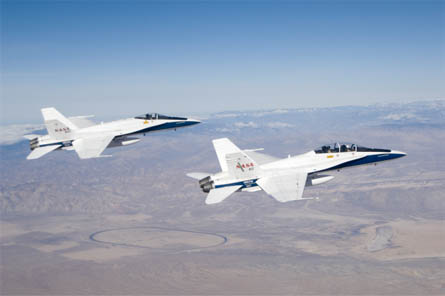NASA has completed another battery of tests with two NASA Boeing F/A-18 fighters to help determine what might be acceptable noise levels for overland supersonic flight, the linchpin for a regulatory overhaul that is likely to spur the birth of a supersonic business jet sector.
The latest tests, carried out at Edwards AFB in California as part of the sonic booms on big structures programme, included measuring low amplitude booms on large buildings, which NASA thinks will be most critical to public acceptance.
Engineers are reviewing post-flight data from pressure transducers installed in a new office building at Edwards to determine the building's structural response to the sonic booms.

©Nasa
The F/A-18s provide different amplitudes of sonic booms by either flying straight and level (loudest) or using diving profiles (quietest) at altitudes between 32,000ft (9,750m) and 49,000ft. In 2006 and 2007, NASA studied the impact of various boom levels on the interior of instrumented houses.
"I'm more convinced our big issue will be disturbance in large structures rather than houses," says Peter Coen, principal investigator for NASA's supersonic fundamental aeronautics programme.
While would-be supersonic business jet developer Aerion is confident it can fly at speeds slightly greater than Mach 1 overland without the accompanying overpressure reaching the surface, others consider the overland ban a death knell for the marketability of aircraft that would otherwise cruise at M1.8 or more.
Gulfstream in particular has supersonic ambitions, but has publicly stated that it will not pursue such a programme under the current regulations. The company has trademarked the aircraft name "Whisper", a probable reference to its patented extendable/retractable nose spike that has been proven to reduce sonic overpressure when extended at cruise.
Gulfstream has compared the resulting noise to a car door shutting rather than the glass-rattling shake that would accompany the overpressure exerted by aircraft such as the Concorde.
Source: Flight International
















